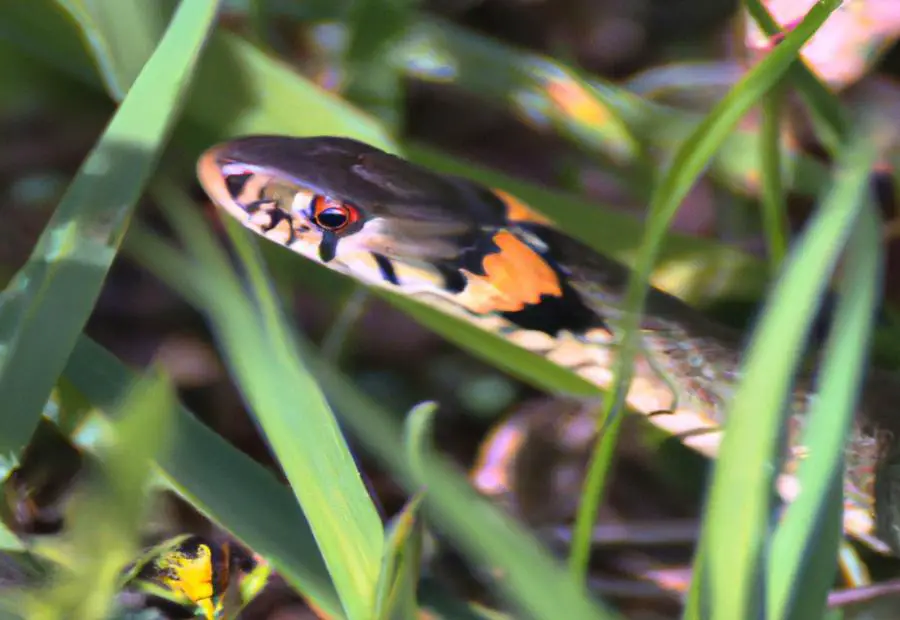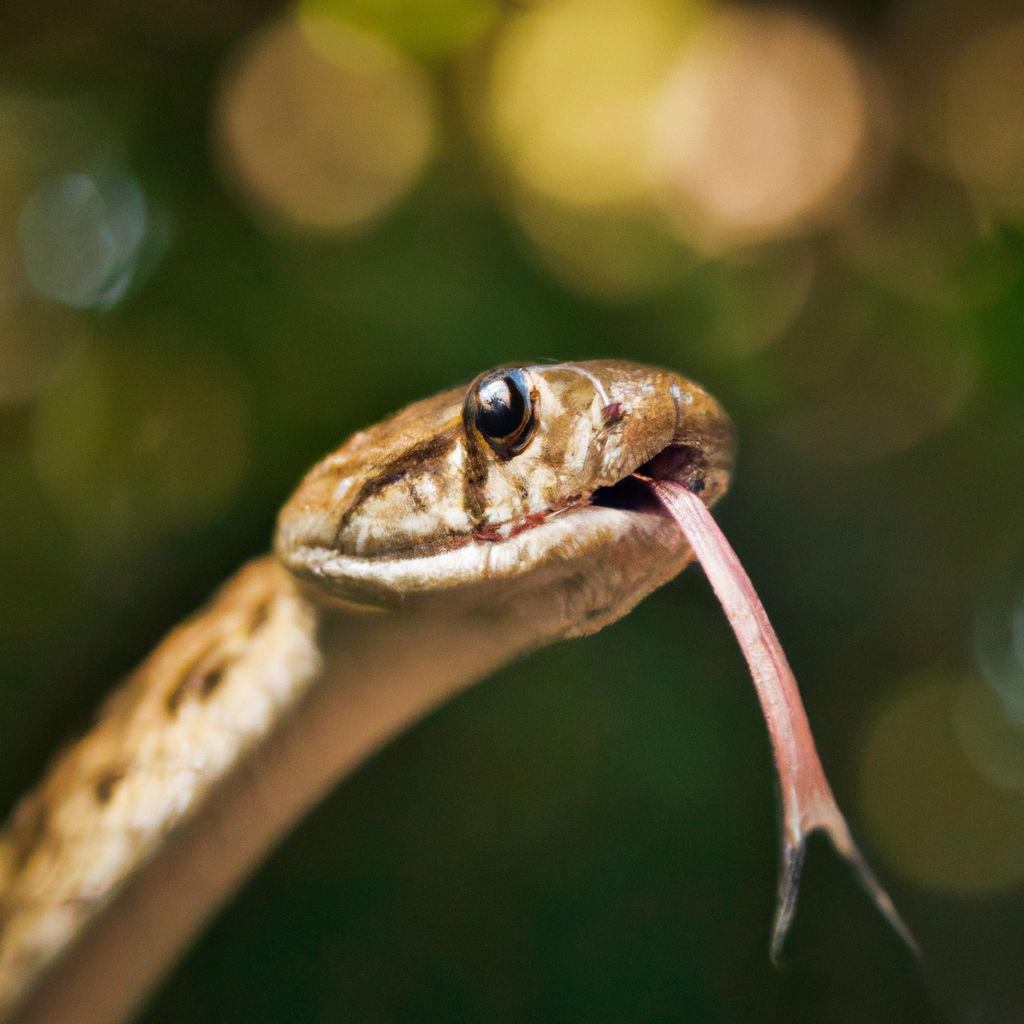Garden snakes, also known as garter snakes, are a common and fascinating species of snakes that can be found in various habitats across North America and other parts of the world. These snakes have a unique diet and hunting techniques that contribute to their survival and success in their respective environments. This article aims to provide an in-depth understanding of what garden snakes eat, how they hunt, their habitat preferences, and the factors that influence their diet.
Garden snakes have a diverse diet that primarily consists of small prey items such as insects, worms, slugs, and snails. They are also known to consume amphibians, small fish, and even small mammals in some cases. Their diet largely depends on the availability of prey in their habitat.
When it comes to hunting, garden snakes exhibit different techniques depending on the type of prey they are targeting. They use their excellent sense of smell and sight to locate their prey and employ various strategies to capture and consume it.
The habitat preferences of garden snakes vary, but they are commonly found in areas with a combination of moisture and cover, such as meadows, forests, marshes, and even suburban gardens. They are highly adaptable and can thrive in a wide range of environments.
Factors such as geographic location and prey availability greatly influence the diet of garden snakes. Different subspecies of garden snakes may have different dietary preferences based on their specific habitats and the availability of food sources.
By understanding the diet, hunting techniques, habitat, and factors that affect the diet of garden snakes, we can gain a deeper appreciation for these remarkable creatures and their role in the ecosystem.
Key takeaway:
- Garden snakes have a diverse diet: They primarily feed on rodents, insects, small birds, and eggs. Understanding their diet is important in managing pest populations and conserving biodiversity.
- Garden snakes employ various hunting techniques: They use stealth, ambush, and constriction to capture prey. Their unique hunting abilities make them efficient predators in their ecosystem.
- The habitat and behavior of garden snakes play a crucial role in their survival: They prefer habitats with abundant vegetation and appropriate shelter. Their activity patterns and seasonal behavior are influenced by temperature and availability of prey.
What Do Garden Snakes Eat?
What’s on the menu for garden snakes? Discovering the dietary preferences of these slithery creatures is the aim of this section. From their primary diet to the common prey they target, we’ll unravel the intriguing feeding habits of garden snakes. Get ready to dive into the fascinating world of these reptilian hunters as we explore their culinary choices and the creatures that often end up on their menu.
1. Primary Diet of Garden Snakes
The primary diet of garden snakes consists mainly of small animals like rodents, insects, and amphibians.[1]
Garden snakes often prey on small rodents, such as mice and rats, which make up a significant portion of their primary diet. They also eat a wide range of insects, including grasshoppers, crickets, and beetles.
Amphibians like frogs and toads are another staple in their primary diet. In addition, garden snakes may consume small birds, lizards, and even other snake species if the opportunity arises.
The primary diet of garden snakes can vary depending on factors like location and prey availability.[5.1][5.2]
Garden snakes have effective hunting techniques, as I witnessed when I saw one swallowing a small mouse in my backyard.
2. Common Prey of Garden Snakes
Common Prey of Garden Snakes:
Garden snakes, also known as garter snakes, have a diverse diet that includes various creatures. Their common prey consists of rodents like mice and rats, which are an excellent source of vital nutrients for them. Additionally, garden snakes are skilled hunters of small birds such as sparrows or finches that make their nests in low branches or shrubs.
Frogs also fall under the common prey of garden snakes, as they are often found in ponds, streams, and marshes. These snakes are known to actively hunt and consume lizards, which are commonly found in outdoor areas. Insects like grasshoppers, crickets, and beetles are an abundant food source for garden snakes, making them an essential part of their diet, especially in gardens and fields.
The adaptability and diverse prey of garden snakes have fascinated humans for centuries. In ancient civilizations, these snakes were highly revered for their ability to control rodent populations and protect crops and stored food. They were even depicted in artwork and folklore, symbolizing wisdom and protection.
Today, humans have come to recognize the ecological significance of garden snakes and their role in maintaining the balance of ecosystems. Understanding their common prey and hunting techniques allows us to appreciate the complexity of nature’s food web.
tags intact, if found.
How Do Garden Snakes Hunt?

Photo Credits: Ruggedreptiles.Com by George Clark
Curious about how garden snakes hunt? Let’s dive into their fascinating hunting techniques and their prey capture and consumption habits. Discover the stealthy strategies and efficient methods these slithery creatures employ as they navigate their habitat in search of a meal. From their impeccable camouflage to their impressive speed and agility, garden snakes have developed a range of hunting skills that make them formidable predators. If you’ve ever wondered about the secrets behind a snake’s successful hunt, this section will unveil all.
1. Hunting Techniques of Garden Snakes
Garden snakes possess a variety of hunting techniques to capture prey. They rely on their advanced sense of smell to locate potential food sources. Once they detect prey, they use their quick reflexes and agility to strike and immobilize it.
Ambush hunting is a skill that garden snakes excel at. They patiently wait for small animals like mice, frogs, and insects to come near and then swiftly attack and seize their prey using their sharp teeth.
Constriction is another hunting technique employed by garden snakes, particularly on larger prey such as birds and rodents. After capturing the prey with their jaws, garden snakes wrap their bodies around it, tightly squeezing to suffocate it. They can adjust the pressure based on the size of the prey.
Garden snakes are also capable of actively pursuing their prey. They slither swiftly and silently to chase down fast-moving animals. This technique is particularly effective when hunting agile prey such as lizards or small birds.
These hunting techniques enable garden snakes to successfully capture a diverse range of prey and ensure their survival in their natural habitats. When observing garden snakes, it is vital to show respect for their role in ecosystems and maintain a safe distance to avoid disturbing or causing harm to them.
2. Prey Capture and Consumption
Prey capture and consumption are crucial aspects of a garden snake’s diet and hunting behavior. The process entails the following steps:
– Garden snakes rely on their sense of smell to identify potential prey.
– They employ their reflexes and agility to strike and capture the prey.
– Utilizing their sharp teeth, they bite the prey in order to immobilize it.
– Through the use of their muscular bodies, garden snakes constrict and suffocate the prey.
– Once the prey is rendered immobile, the garden snake swallows it whole, beginning with the head.
– Garden snakes possess the remarkable ability to dislocate their jaws, allowing them to consume prey larger than their own heads.
– During digestion, the snake’s potent stomach acids break down the prey’s body and extract vital nutrients.
If you have garden snakes in your garden, it is important to acknowledge their role in controlling populations of small mammals and insects. Rather than causing harm, it is advisable to create a snake-friendly environment by providing hiding places such as rock piles or log piles. This promotes the development of a healthy ecosystem and maintains a natural balance in your garden.
Garden Snake Habitat and Behavior
Garden snakes, fascinating creatures with unique habits and preferences, are found in a variety of habitats. In this section, we’ll uncover their preferred habitats and delve into their intriguing activity patterns and seasonal behavior. Brace yourself for a journey into the world of garden snakes, where we’ll explore their hidden habitats and attempt to unlock the secrets of their mesmerizing behavior. Get ready to be amazed by the wonders of these slithery reptiles!
1. Preferred Habitats of Garden Snakes
Preferred Habitats of Garden Snakes
The habitats that garden snakes prefer are gardens, grasslands, forests, wetlands, and rocky areas.
In gardens, these snakes are drawn to the abundance of prey such as rodents, insects, and amphibians.
In grasslands, garden snakes can conceal themselves in tall grass and search for food. The open spaces and vegetation in these areas make them excellent hunting grounds.
Certain species of garden snakes can be found in forests that have dense vegetation. While searching for food, they utilize fallen logs, rocks, and leaf litter as cover.
Garden snakes inhabit wetlands such as marshes, swamps, and ponds. These habitats provide a wide variety of prey, including frogs, tadpoles, and small fish.
Some species of garden snakes have a preference for rocky habitats. They take shelter in crevices and hunt among the rocks. These snakes are adept climbers and can easily navigate rocky terrain.
The specific habitat preferences may vary depending on the species of garden snake and its geographical location.
2. Activity Patterns and Seasonal Behavior
The activity patterns and seasonal behavior of garden snakes provide valuable insights into their routines and habits.
Garden snakes have different activity patterns depending on their species and geographic location. For instance, in warmer regions, they are more active year-round due to the favorable climate. In contrast, in colder regions, they may hibernate during winter.
Breeding seasons and mate-seeking behaviors also influence their activity levels. Understanding these activity patterns and seasonal behaviors is crucial for researchers and enthusiasts as it allows for better observation, study, and conservation efforts.
Respecting their natural rhythms ensures the thriving of garden snakes in their habitats.
Factors Affecting Garden Snake Diet
Did you know that the diet of garden snakes can be influenced by various factors? In this section, we will explore the different elements that play a role in determining what garden snakes eat. From their geographic location to the availability of prey, we’ll uncover how these factors shape their dietary choices. Get ready to discover the fascinating interplay between garden snakes and their environment when it comes to their dietary habits.
1. Geographic Location
The diet and habitat of garden snakes are determined by their geographic location. Various snake species can be found in different regions around the world.
| Region | Snake Species |
|---|---|
| North America | Garter snakes, rat snakes, milk snakes |
| Europe | Grass snakes, smooth snakes, adders |
| Australia | Tiger snakes, brown snakes, red-bellied black snakes |
| Asia | Cobra, king cobra, Russell’s viper |
Garden snakes adapt to the specific environments of their regions. For example, in North America, garter snakes are commonly found near water sources and mainly eat amphibians and fish. European grass snakes, on the other hand, prefer grassy habitats and primarily feed on frogs and small mammals. In Australia, venomous snake species like the tiger snake are prevalent and consume rodents and reptiles. Asian cobras inhabit a wide range of environments and have a varied diet that includes rodents, birds, and other snakes.
Understanding the geographic location helps researchers and enthusiasts study the diversity and behavior of garden snakes. By knowing the snake species present in a region, experts can determine the typical prey items available and the potential risks associated with interacting with these snakes.
One interesting story related to geographic location is the discovery of a new snake species in the remote rainforests of South America. Scientists exploring the region stumbled upon a brightly colored snake previously unknown to science. The unique habitat and isolation of the area allowed this snake species to evolve independently, highlighting the importance of geographic location in biodiversity.
2. Availability of Prey
Garden snakes are opportunistic predators that rely on the availability of prey to meet their dietary needs. They have a diverse diet, feeding on insects like ants, beetles, and grasshoppers, as well as small mammals such as mice, voles, and shrews. Additionally, they consume amphibians like frogs, toads, and newts, reptiles such as lizards and small snakes, birds like sparrows, finches, and warblers, and even bird and reptile eggs.
The abundance of these prey items in the snakes’ habitats is crucial for their survival. Factors like seasonal variations and the overall health of the ecosystem can impact prey availability. In areas with a high density of prey, garden snakes can feed more frequently to meet their nutritional requirements.
To attract a greater number of prey and, consequently, garden snakes, it is recommended to create a garden that provides suitable habitat and food for insects and small animals. This not only helps maintain a balanced ecosystem but also reduces the need for chemical pest control methods.
Some Facts About What Do Garden Snakes Eat? Diet and Habitat Explained:
- ✅ Garter snakes are common in North and Central America and are typically medium-sized non-venomous snakes. (Source: Our Team)
- ✅ Garter snakes have a wide range of habitats including forests, fields, wetlands, and even urban environments like parks and gardens. (Source: Our Team)
- ✅ Eastern garter snakes primarily feed on toads, frogs, slugs, and worms as part of their carnivorous diet. (Source: Our Team)
- ✅ Garter snakes have a polygynandrous mating system where both males and females mate with multiple partners. (Source: Our Team)
- ✅ Female garter snakes give birth to live snakelets after a gestation period of 2-3 months, and the young are independent from their mother. (Source: Our Team)
Frequently Asked Questions
What do garter snakes eat?
Garter snakes are strict carnivores and have a varied diet. Their main diet in the wild consists of small frogs, toads, earthworms, and occasionally small snakes and lizards. As pets, it is best to feed them mice, either frozen or live, as they provide complete nutrition. However, it is important to avoid feeding them frogs due to the potential for parasites.
Do garter snakes eat dead animals?
No, garter snakes do not eat dead or decomposing animals. They prefer to hunt live prey and are skilled at capturing small and weak animals due to their lack of powerful venom or the ability to constrict their prey.
What are some predators of garter snakes?
Garter snakes have a range of predators including foxes, bears, raccoons, hawks, snapping turtles, crows, eagles, herons, owls, and larger snakes like kingsnakes and coral snakes. To defend themselves, garter snakes can emit a foul-smelling secretion from their glands as a deterrent.
How do garter snakes locate their prey?
Garter snakes are skilled hunters that use their lightning-fast reflexes, excellent sight, and keen sense of smell to locate and stalk their prey. They have a vomeronasal organ that interprets scents and alerts them to the presence of prey or predator animals.
What is the size range of garter snakes?
Garter snakes are typically 23-30 inches long, but some species can reach up to 5 feet in length. They have three longitudinal stripes running down their backs and can have a wide variety of colors and patterns, including blotches of color and a yellow stripe.
Where are garter snakes commonly found?
Garter snakes, such as the Eastern garter snake, are common throughout North America, including in eastern regions from southern Ontario and Quebec to the Gulf of Mexico. They can be found in various habitats such as forests, grassy or shrubby fields, abandoned farmland, urban environments like city parks, and even suburban yards and gardens.

